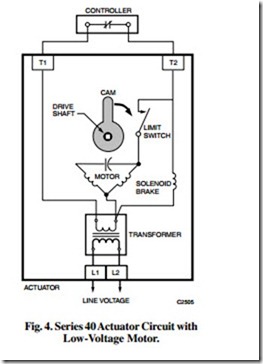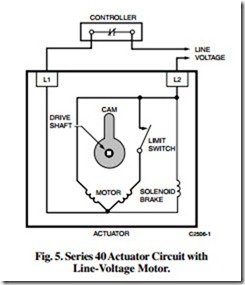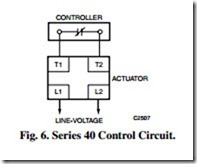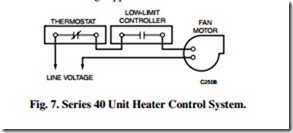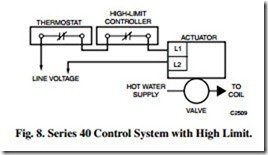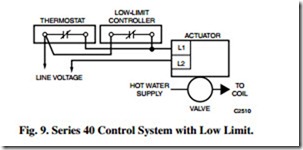SERIES 40 CONTROL CIRCUITS
APPLICATION
A Series 40 circuit is a line-voltage control circuit which is switched directly by the single-pole, single-throw switching action of a Series 40 controller. A Series 40 control circuit is two position and requires two wires. It can be used to control fans, electric motors, lights, electric heaters, and other standard line-voltage equipment in addition to relays and spring-return actuators.
The equipment controlled is energized when the controller switch is closed and deenergized when the switch is open.
Normally, a Series 40 controller closes and opens the circuit load directly. However, when a load exceeds the contact rating of the controller, an intermediate (pilot) relay with higher contact ratings must be used between the controller and the load circuit.
Also a relay can be used if a load circuit requires double- or multi-pole switching action. The Series 40 controller energizes the coil of the relay to actuate the contacts.
Series 40 controllers which operate at line voltage must be wired according to codes and ordinances for line-voltage circuits. Series 40 controllers when used to switch low voltage can be wired according to low-voltage circuit requirements.
RELAYS
A Series 40 relay consists of a line-voltage coil which operates an armature to control one or more normally open or normally closed, or single-pole, double-throw contacts.
ACTUATORS
Series 40 actuators usually operate valves or dampers. The actuator is electrically driven through its stroke (usually either 90 or 160 degrees) when the controller contact is closed. A limit switch in the motor opens at the end of the power stroke, the actuator stops, and the drive shaft is held in position by a solenoid brake (Fig. 4), or one of the motor windings (Fig. 5), as long as the circuit is closed. When the controller circuit opens or a power failure occurs, the solenoid brake (or motor winding) releases and an integral spring returns the actuator to the deenergized position. Series 40 actuators should be used in applications that do not require frequent cycling due to the high speed spring return.
EQUIPMENT
CONTROLLERS
1. Temperature controllers.
2. Pressure controllers.
3. Humidity controllers.
4. Other two-position devices that have a normally open or normally closed contact action such as a line-voltage relay.
In these controllers, either snap-acting or mercury switch contacts close and open the circuit. In most cases, Series 40 controllers are snap-acting. Series 40 controllers can be used in low-voltage circuits, but low-voltage controllers cannot be used in Series 40 line-voltage circuits.
Most Series 40 actuators have low-voltage motor coils and a built-in line-voltage to low-voltage transformer. Power to the unit is line voltage but the control circuit in the motor is normally low voltage. These actuators can use either a Series 40 line- voltage controller or a Series 80 low-voltage controller and are wired as shown in Figure 4. Series 40 controllers can also be used in the line-voltage supply to the actuator.
Some Series 40 actuators have line-voltage motor coils and can use either a Series 40 line-voltage controller or a Series 60 two-position controller (which is also line voltage) and are wired as shown in Figure 5.
OPERATION
A simple Series 40 circuit is shown in Figure 6. It consists of:
1. A Series 40 (or 80) controller.
2. A Series 40 actuator with low-voltage control circuit.
When the controller switch is closed as in Figure 6, the actuator drives to the open limit where it is held by the solenoid brake. When the controller switch is open, the actuator returns to its spring-return position. Series 80 controllers cannot be used with actuators having a line-voltage control circuit.
CONTROL COMBINATIONS
UNIT HEATER CONTROL
In unit heater control (Fig. 7) it is usually necessary to keep the heater fan from running to prevent circulation of cold air when heat is not being supplied to the heater coils.
The thermostat controls the fan motor from room temperature.
The low-limit controller is a reverse-acting temperature controller installed with the sensing element in the steam or water return from the unit heater. It is connected in series with the thermostat and fan motor and prevents the fan from operating until the medium flow is established through the coil. With large fan motors, a relay must be added to handle the motor load.
HIGH-LIMIT CONTROL
Figure 8 shows a Series 40 thermostat and a high-limit controller operating a hot water valve. The thermostat controls the hot water valve from room temperature. The high-limit controller is located in the discharge of the heating coil to prevent excessive discharge air temperatures. The high-limit controller is wired in series with the thermostat and valve so that it opens the circuit to the valve on a rise in discharge temperature to the high-limit setting.
LOW-LIMIT CONTROL
A low-limit controller is connected in parallel with the thermostat as shown in Figure 9. The low-limit controller can complete the circuit to the valve actuator even though the thermostat has opened the circuit. The actuator remains energized when the contacts on either controller are closed.
